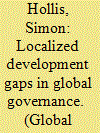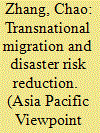| Srl | Item |
| 1 |
ID:
155390


|
|
|
|
|
| Summary/Abstract |
Third United Nations World Conference on Disaster Risk Reduction was held in Sendai, Japan in March 2015, four years after the Great East Japan Earthquake struck on March 11, 2011. Attended by some 150,000 participants from around the world, the Conference adopted the Sendai Declaration and the Sendai Framework for Disaster Risk Reduction 2015–2030, the latter of which was the successor document to Hyogo Framework for Action. Besides significance in efforts to prevent and mitigate disasters, the successful formulation and adoption of the Sendai Framework served to promote collaboration on UN and other conferences held later that year. Disaster Risk Reduction principles of reducing vulnerabilities and enhancing resilience are especially necessary in the Asia-Pacific region which is over-represented in natural disasters. In December 2015, efforts by Japan and 141 other co-sponsors resulted in a UN Resolution to designate the 5th of November “World Tsunami Awareness Day.”
|
|
|
|
|
|
|
|
|
|
|
|
|
|
|
|
| 2 |
ID:
142234


|
|
|
|
|
| Summary/Abstract |
While the importance and key features of transnational benchmarking have received increased attention in recent years, the organisational contexts of this benchmarking have not yet been analysed systematically enough. Drawing on actor-network theory, this article identifies two key aspects of these contexts. The first is embeddedness, which refers to the degree to which there are networks that carry information and action from the benchmark to its contexts and back that are sustained institutionally, including by technical artefacts, objects, and routine local practices. Embeddedness is critical to the effectiveness of benchmarking. The second is publicness, which refers to the degree to which these networks exhibit expanding flows of information across widening circles of engagement, or instead are marked by control, domination, and exclusion. The article argues that benchmarking as a form of governance has an inherent impetus toward greater publicness, although this can be prevented by self-interested actors or problems associated with embeddedness. The article then explores the relevance of these conceptual points by examining cases of transnational benchmarking: disaster risk reduction and supply chain management.
|
|
|
|
|
|
|
|
|
|
|
|
|
|
|
|
| 3 |
ID:
151679


|
|
|
|
|
| Summary/Abstract |
Global framework agreements on disaster risk reduction aim to reduce the vulnerability of states from the effects of natural hazards and guide international development strategies. The effects of these agreements have surely saved lives and buffered shocks to economic systems. Yet there remains a gap between global aims and envisioned outcomes in local communities. This article argues that cultural determinants of risk, which shape the reception and translation of ideas on DRR, must be taken seriously if international organizations wish to enhance their efficacy and reduce vulnerability. Elucidating the importance that indigenous practices of resilience, time, and governance have for the global diffusion of DRR can help to reduce this gap and encourage more effective development policy in the future.
|
|
|
|
|
|
|
|
|
|
|
|
|
|
|
|
| 4 |
ID:
182698


|
|
|
|
|
| Summary/Abstract |
Migrants can be disproportionately impacted by disasters due to their increased vulnerability. Knowledge of Chinese migrants' perceptions and experiences in the face of hazards and disasters is limited. This qualitative descriptive study explored Chinese migration in relation to disasters and disaster risk reduction in New Zealand. Semi-structured interviews with 22 Chinese migrants living in Auckland were conducted and data were thematically analysed. Participants displayed strong transnationalism via the creation of ‘mini-China’ and conceptions of China as their ‘mother’ country and New Zealand their ‘step-mother’ country. Chinese migrants compared their experiences of disasters in China to those in New Zealand, with many expressing difficulties with accessing information and not trusting New Zealand government authorities, particularly given how the approach contrasts to China's more ‘hands on’ approach. Fear of losing life and property and responsibility to their family were key factors underpinning Chinese migrants' decision to prepare for a disaster. Participants shared insights to guide disaster risk reduction efforts from a community level and expressed a willingness to participate in disaster preparedness organised by agencies involved in disaster risk reduction. The findings indicate capacities of Chinese migrants that planners can leverage and highlight important cultural nuances that need attention in future planning.
|
|
|
|
|
|
|
|
|
|
|
|
|
|
|
|